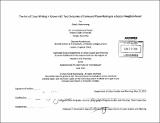The art of cross-writing in Grove Hall : two centuries of form and place-making in a Boston neighborhood
Author(s)
Rosenzweig, Gilad J
DownloadFull printable version (23.44Mb)
Other Contributors
Massachusetts Institute of Technology. Department of Urban Studies and Planning.
Advisor
Annis Whitlow Sengupta.
Terms of use
Metadata
Show full item recordAbstract
The Boston neighborhood of Grove Hall is presently engaged in a period of urban revival. New civic, commercial and residential projects are starting to fill in empty lots and rejuvenate historic yet dilapidated structures. Once the vibrant heart of the Jewish community, Grove Hall has for over half a century been an almost exclusively African- American and black immigrant neighborhood. The area experienced a complete demographic transition in the 1950s and 1960s, when the Jewish population moved to the suburbs of Boston. The incoming black community, the majority of whom were recent migrants from the American south, inherited a seventy-year old neighborhood, rich in historic architecture and form, but also ripe with problems of an aging infrastructure and housing stock. Moreover, the era of this transition was a turbulent period in U.S. political and social activity; white and black populations were deeply polarized as they laid separate spatial claim to neighborhoods across the country. Within this context, the transition of Grove Hall had failed to transfer a successful urban environment to its next group of inhabitants. A long period of decline overcame the neighborhood, marked by the collapse of commercial activity, the loss of almost half its population, and the influx of a tiny yet strangling criminal element. Though it is often categorized as an 'inner-city' neighborhood, Grove Hall did not suffer the same fate as many similar districts in other U.S. cities. Its streets and houses were not destroyed for urban renewal, or ripped apart to create freeways; the original street pattern, and most of its classic buildings, survived years of decay. Thus, instead of replacing urban form, there is evidence that Grove Hall is instead adding more to it, re-writing its physical space in a continuation of neighborhood evolution. Using the concept of cross-writing, a nineteenth century technique of writing multiple 'crossed' layers of a letter on one page to produce a greater piece of text, my research hypothesizes that previous, even latent, layers of good form overlain with new and engaging design, can produce successful urban space.
Description
Thesis (M.C.P.)--Massachusetts Institute of Technology, Dept. of Urban Studies and Planning, 2013. Page 149 blank. Cataloged from PDF version of thesis. Includes bibliographical references (p. 138-148).
Date issued
2013Department
Massachusetts Institute of Technology. Department of Urban Studies and PlanningPublisher
Massachusetts Institute of Technology
Keywords
Urban Studies and Planning.